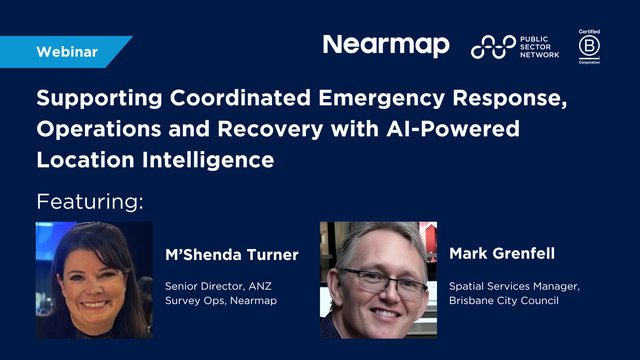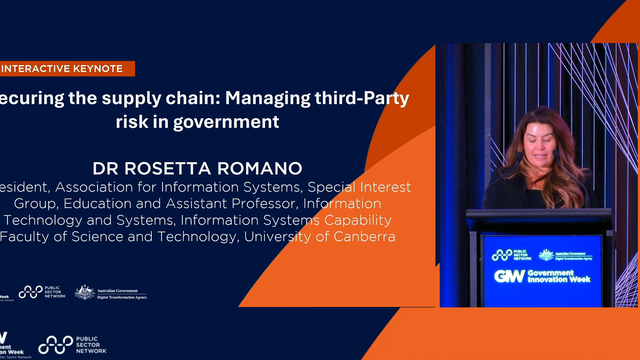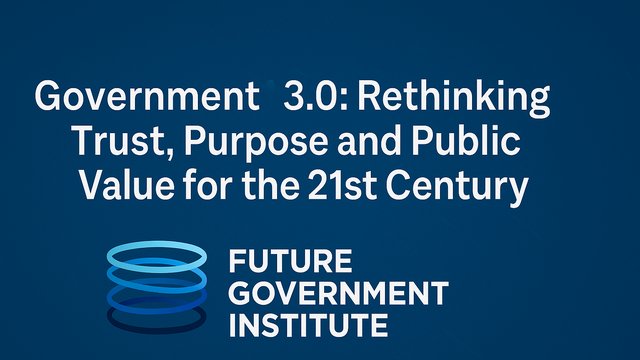


What will AI look like by 2030?
2030 is much closer than it used to be
We once talked about 2030 as the distant future, but now it's just 5 1/2 years away. However, given the rapid pace of technological change, a lot will still happen in that time. In the meantime, many parts of government in Australia are struggling to engage with AI effectively and to reap its benefits.
For many, AI seems to have suddenly fallen from the sky with the advent of ChatGPT, generative AI and large language models. However, AI has been around for a long time. Initially, AI was something that could do a narrow task very well: adapting over time, filtering information and improving over time with a specific tasks. Recently, it has been applied to a much wider range of areas. The most successful applications we have seen so far focus on addressing the complexity of government systems, joining up disconnected processes, navigating policies, and summarizing documents. People are just beginning to work out how to use AI to grapple with the complexity of government.
What to expect
Over the years to 2030, it is inevitable that the public will increasingly demand that government do things differently. As services in every other sector become increasingly personalized, joined-up and responsive to individual needs, it is inevitable that the public will expect, even demand this of government. This is an expectation that AI can help with. The uses of data, digital channels and AI that help companies engage with customers can also help governments treat the public in a much more customer-centric way and reflect the “life journeys” of individuals as opposed to forcing people to face the siloed structures reflecting individual government agencies. Creating seamless interactions with government around “life journeys” or significant events such as the birth of a child, the death of a loved one, transitioning to retirement, or even just getting a job are all areas where government services can be delivered in a customer-centric way.
There are many such life journeys and significant events, but not all of them are ones we choose or have the option of engaging with government on. Some areas of government, like justice, are impossible to avoid—you can't opt out if you're arrested, fined, or summoned to court. However these areas could also benefit remarkably from use of data, digital channels and AI to create more customer-centric experiences.
The administration of justice is notoriously slow compared to other services, which is increasingly out of step with the digital economy and public expectations.
For example, long waiting times for hearings, and lengthy durations in the court system contrast sharply with the speed and efficiency of other services. The New South Wales Local Court aims to finalise its caseload within set time standards. For civil cases: 90% of civil cases finalized within 6 months of the initiation of the proceedings in the court, and 100% of cases within 12 months. Actual performance is often far worse than this, but even the targets seem extreme compared to every other service we engage with outside of government. Who would happily wait 12 months for an electrician to finish a task, or for a surgeon to finish an operation? While the matters considered within the court system are weighty, and the consequences serious, increased use of data, digital and AI could have significant impact on the process of administering justice and the speed with which relevant case law and other information can be identified and processed. In some cases, it may even be used to triage disputes at an early stage to improve the quality of cases that finally do enter the court system.
If government services don't meet public expectations, people seek alternatives. The regulated taxi system was completely disrupted by Uber offering a different type of ridesharing service. Governments around the world then played catch-up trying to adapt the taxi model to this new approach. Similar disruptions happened in other sections of the “Gig economy” with governments everywhere caught off guard. Disruption could and will happen in other areas and AI could both help cause the disruption, and offer solutions.
Justice is a standout because there is currently no alternative to engaging with some parts of the system. Arguably, as the population and the economy grows, the demands on the justice system will also grow. If this area of government does not adopt data-driven tools and AI, it risks being unable to meet that growing demand. When government cannot meet the demand for services, something has to give, and this often puts great stresses on society.
The Vision for 2030: Simplified Governance
Looking ahead at that now just half a decade to 2030, I hope AI will be deeply embedded and commonly used. For example, today, navigating life events such as moving to a new state, the birth of a child, or the death of a loved one involves navigating a complex web of information and interactions. AI could simplify this navigation by finding all relevant information based on a specific set of circumstances, and stepping someone through all the stages they need to consider. It can also join up the steps of the process which do not need decisions, or only low complexity decisions.
As we approach 2030, it’s important for us to have a view on what we want the world to look like, and then work backward to determine the steps needed to achieve that vision.
Imagine a government that allows for seamless interactions - where engaging with those life journeys are as simple as booking a hotel online. AI should eliminate the complexity and friction in engaging with government and increasingly integrating different government functions. AI can allow government to look like it really is built around the unique needs of every single one of us. This is a join-up view of government which is also cybersecure, privacy preserving, and does not over-reach in terms of just how personal governments get with each of us. After all, who wants a highly personalized infringement notice?
However, there are many other applications where governments can explore delivering using AI to deliver “old” services in new ways. Recently, NSW announced the use of AI-driven vision software to detect if passengers are wearing seat belts. This application enforces an existing law in a novel way, by examining every car passing under the camera to check if passengers are complying. The AI recommends images it “believes” is showing infringing behaviour to a human for final decision on issuing a fine. This builds on the successful roll out of AI used to detect drivers using mobile phones and similarly, making recommendations to human operators to issue fines.
The challenge is to strike a balance along a number of dimensions. We need to ensure we do not inadvertently create a surveillance state and that, ultimately, people are still making the decision about the course of action even if recommended by an algorithm. It also requires the impersonal nature of due process to balance with the “personalised” nature of joined-up government. We may well choose to have barriers between what government knows about us when it comes to health and social services, and what government knows about us from a tax and justice perspective.
The Future with AI walks a Fine Line
Recently, I heard about AI being used in another country to automatically issue fines when someone drives into a no-stopping zone. While this is arguably an efficient closed-loop use of data and AI, but it seems ruthlessly unforgiving and heavy handed. We need to carefully consider the implications of such surveillance and enforcement of legislation. Currently, enforcement involves a lot of human factors such as judgement, awareness, and presence. How do we balance efficiency with these human elements? Keeping our eyes on that vision 2030 and the details underpinning the headline outcomes we striving for.
Looking ahead to 2030, I hope AI will handle the mundane tasks, making systems more cohesive and addressing any inconsistencies or gaps. Ideally, AI will highlight issues for humans to address. I also hope that while governments use AI to fulfil their roles, they do so with real exercise of judgement and using frameworks of assurance, ensuring laws are applied and services delivered without creating a dystopian surveillance state.
What we're doing right: Consistent Standards and Domestic Collaboration
We’re going to arrive at 2030 either way. On the positive side, we’re making progress in ensuring consistency at a national level regarding AI assurance. The Australian Government has recently introduced the Australian AI Assurance Framework, which builds on the NSW AI Assurance Framework. The NSW framework provides risk-based principles that guide how AI should be managed. Consistency across states is crucial—having different systems in South Australia compared to NSW and Victoria would be problematic.
Additionally, it’s encouraging that standards for data sharing and AI management are being developed. These standards are essential for setting clear definitions, and consistent guidelines and expectations as we move forward with AI technologies.
Where we’ve got to do better: Risk management and International Collaboration
While principles are helpful for understanding the big picture, they are inadequate when it comes to practical implementation. Principles alone don’t address the detailed, step-by-step needs of managing AI risks and applications. Without a detailed, risk-based approach like the one NSW has taken, it’s challenging to evaluate and mitigate specific risks associated with AI.
Another concern is that government often fails to engage with existing and developing international frameworks. If governments lack technical expertise in the field, there’s a real risk of either reinventing the wheel or remaining at the principles level. It’s like a group of people discussing how to change a tyre without actually using the tools to do the job. For AI, this means there’s a danger of focusing on high-level principles without diving into the implications of data, algorithms, and their real-world applications. To move forward effectively, we need to address these details and engage more deeply with international standards and practices.
Roadmapping the next five-and-a-half years
To reach the level of seamlessness outlined in the 2030 vision, we need to start by simplifying the complex web of government interactions.
Currently, navigating government is challenging due to the sheer volume of information and the three layers of government in Australia, which can create an "embarrassment of choices."
For instance, the housing crisis in Australia highlights this complexity: different local governments, state regulations, and Commonwealth considerations all contribute to a convoluted process for housing development approvals.
To improve, we need to focus on several key areas:
Information Access: First, we need to make finding and understanding government rules and regulations easier. This means simplifying access to information and creating a more user-friendly way to engage with it. This is not “plain English” websites, this is personalised navigation tools.
Data Integration: Next, we should aim to integrate and digitize data across various government levels. For example, in the housing sector, having a digital system that allows users to visualize their projects, engage in an intuitive way with planning requirements, automatically submit for approval, and track progress would streamline the entire process.
Reducing Complexity: Finally, addressing the friction points in current systems—where rules and processes create confusion—will be crucial. This involves digitizing rules and processes, connecting them seamlessly, and identifying and eliminating points of friction or "sludge."
By focusing on these areas, we can transform government interactions to be as intuitive and efficient as possible, making it easier for people to navigate and engage with government services. The goal is to create a future where the process is clear and straightforward, eliminating unnecessary complexity and ensuring that everyone knows exactly what steps to take next.
This article is part of a series designed to envision and meet a future of what AI could enable in the public sector. Read Ian Oppermann’s profile or tune in next week for part 2: Hurdling the Key Barriers to AI 2030
Published by
About our partner

ServiceGen
ServiceGen was founded by Victor Dominello, who led the groundbreaking transformation of Government services in NSW by building the State’s digital capabilities to deliver excellence in services.For seven consecutive years, NSW was top ranked in the Intermedium Australia & New Zealand Digital Government Readiness and Maturity Indicator Report. NSW Government was ranked No1 in ease of services and No 2 in level of trust compared to other Australian states and countries including US, UK, Singapore, Canada & NZ. NSW was also the first Australian state to develop a responsible AI Assurance Framework.Victor identified that while Governments want to transform their services for citizens, the institutional barriers to achieving it are significant and can take a long time to overcome. He led the service transformation journey for the last 10 years and NSW was one of the world’s first jurisdictions to implement a digital driver’s licence.Victor created ServiceGen to give Governments the benefit of this experience so they can achieve similar success in a much faster time. Built on the principle that customers should have control and choice over the way they access Government services, the Service NSW platform is loved by NSW residents and recognised globally as the leading benchmark.ServiceGen aims to help Governments accelerate digital service delivery by:- Growing citizen trust and enhanced experience- Achieving institutional cut through- Improving the customer experience, while providing secure transactions.
Learn more
































